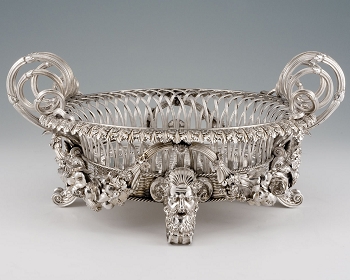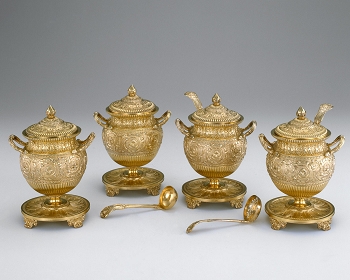Paul Storr (1771 - 1844)
Biography
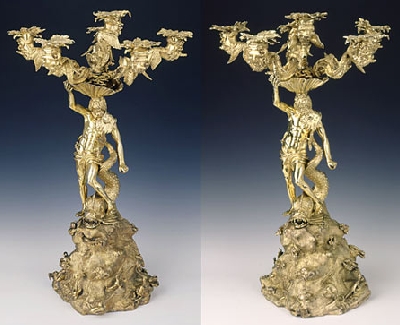 A pair of 6-light candelabra, Paul Storr, 1819, Victoria & Albert MuseumPaul Storr (1771 in London–4 March 1844) was a British silversmith sculptor, and designer working in the Neoclassical style. An example of his work is the cup made for the British admiral Lord Nelson to signify his victory at the Battle of the Nile.
A pair of 6-light candelabra, Paul Storr, 1819, Victoria & Albert MuseumPaul Storr (1771 in London–4 March 1844) was a British silversmith sculptor, and designer working in the Neoclassical style. An example of his work is the cup made for the British admiral Lord Nelson to signify his victory at the Battle of the Nile.
Paul's father, Thomas, was a chaser, a skilled tradesman whose job involved the creation of patterns and designs on silverware. Paul followed his father into the metalwork profession, and in 1785 became an apprentice silversmith.
Paul served a seven year contract with Andrew Fogelberg, a well-known Swedish national who had moved to London in 1770. In Fogelberg's workshop, Paul received a thorough grounding in every aspect of the silversmith's art.
After his apprenticeship, Paul teamed up with a colleague, William Frisbee, and together they registered their marks with the Assay Office. Within a further year, Paul felt confident enough to register a mark in his own right.
By 1796, Paul's remarkable skill had made him so successful he opened a workshop in Air Street, London. His style at this time followed the current neoclassical fashion, although his pieces were often plainer than the work of his contemporaries.
In 1800, the Royal Goldsmiths, Rundell and Bridge (later known as Rundell, Bridge and Rundell) asked Paul to sell most of his work through their exclusive London shop. Paul agreed, and changed his style to match the elaborate forms preferred by Rundell and Bridge's wealthy patrons.
One successful piece followed another, and Paul Storr silverware developed an international reputation. Rundell, Bridge and Rundell acknowledged this, and accepted Paul as a partner in the firm in 1811. In the same year, Paul moved his workshop to premises in Dean Street, London.
Eight years later, in 1817, Paul left Rundell, Bridge and Rundell and once again became freelance. The move was accompanied by another change in his work, this time to the naturalistic forms of the Rococo, a genre that was experiencing a popular revival.
After three years of independence, Paul went into partnership with another retailer, this time John Mortimer. The firm they created, Storr & Mortimer, sold Paul's work though Mortimer's outlet in Bond Street, London. The partnership survived until 1838 when Paul retired.
Paul Storr's reputation rests on a number of factors. Firstly, there was his skill as a silversmith, and his absolute mastery of technique. Secondly, there was his astonishing attention to detail. This applied not just to design but to the finishing of a piece so that the overall effect was one of distinction and beauty. Finally, there was his understanding of the nature of silver, and his ability to turn the ideas of designers into concepts that perfectly matched the versatility and limitations of the metal.
After Paul de Lamerie's Abalone Shell Salts
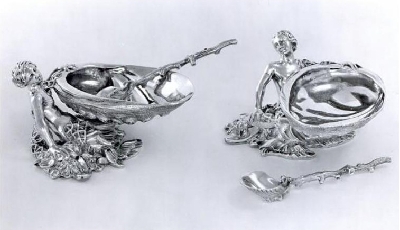 A pair of Salts and Spoons by Paul Storr, London, 1819.A pair of salts and spoons were made by Paul Storr in 1819/29, London. These salts and spoons are exact reproduction of four made by Paul de Lamerie in 1739. Storr borrowed freely from de Lamerie's work and is known to have supplemented objects originally supplied by the earlier goldsmith. There are minor differences in the chasing of the Storr examples, for instance in the face of the mermaids and on the stems of the spoons. Each of the Storr salts has a casting hole in the underside center of its base, and one has an additional hole beneath the hand of the mermaids.
A pair of Salts and Spoons by Paul Storr, London, 1819.A pair of salts and spoons were made by Paul Storr in 1819/29, London. These salts and spoons are exact reproduction of four made by Paul de Lamerie in 1739. Storr borrowed freely from de Lamerie's work and is known to have supplemented objects originally supplied by the earlier goldsmith. There are minor differences in the chasing of the Storr examples, for instance in the face of the mermaids and on the stems of the spoons. Each of the Storr salts has a casting hole in the underside center of its base, and one has an additional hole beneath the hand of the mermaids.
All six salts were auctioned by Clark in 1930 as a set.
[Salt] H:5.0cm, L:10.2cm, W:10.0cm, WT:297g, [Spoon] L:9.8cm, WT:21g
 Set of Four Salts and Spoons by Paul de Lamerie, London, 1739. These salts were acquired by Clark with two identical copies supplied by a victorian silversmith Paul Storr in 1819The four salts, marked by Paul de Lamerie in 1739/40, were acquired by Clark in 1930 with two identical copies by Paul Storr dated 1819/20. A set of four cast salts with accompanying spoons illustrates the marriage of naturalism and fantasy so characteristic of the rococo style. Each salt is conceived as a abalone shell supported by a mermaid draped in netting, encrusted with sea shells and coral. Sea shell and coral spoons continue the marine theme.
Set of Four Salts and Spoons by Paul de Lamerie, London, 1739. These salts were acquired by Clark with two identical copies supplied by a victorian silversmith Paul Storr in 1819The four salts, marked by Paul de Lamerie in 1739/40, were acquired by Clark in 1930 with two identical copies by Paul Storr dated 1819/20. A set of four cast salts with accompanying spoons illustrates the marriage of naturalism and fantasy so characteristic of the rococo style. Each salt is conceived as a abalone shell supported by a mermaid draped in netting, encrusted with sea shells and coral. Sea shell and coral spoons continue the marine theme.
(1) For examples, see Arthur Grimwade, "Family Silver of Three Centuries," Apollo, vol. 82 (December 1965), p. 500, Fig. 4; and Arthur G. Grimwade, The Queen's Silver, A Survey of Her Majesty's Personal Collection (The Connoisseur, London, 1953), Pl. 17.
Silver in the Clark Art Institute - Sterling and Francine Clark Art Institute, Magazine Antiques, Oct, 1997 by Beth Carver Wees
Tea set with teapot, creamer, and sugar bowl, 1813–14
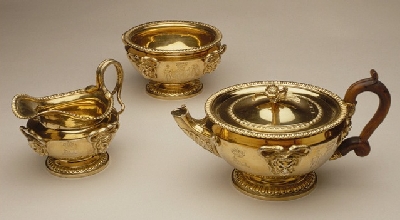 Tea set with teapot, creamer, and sugar bowl, 1813, Paul Storr, Metropolitan Museum of ArtSilver-gilt, H. of teapot 14 cm, Max. W. of teapot 26.4 cm, Metropolitan Museum of Art
Tea set with teapot, creamer, and sugar bowl, 1813, Paul Storr, Metropolitan Museum of ArtSilver-gilt, H. of teapot 14 cm, Max. W. of teapot 26.4 cm, Metropolitan Museum of Art
This tea set is an example of work done by Paul Storr while working exclusively for the firm of Rundell, Bridge & Rundell, which supplied designs.
The set is probably from a design by William Theed II (1764–1817), who was a product of the art school connected with the Royal Academy. He spent time in Rome and Naples before returning to England as a designer, modeler, and sculptor. From 1803, he was principle designer to the Rundell firm.
The teapot is inspired by an ancient Roman hand lamp, the spout recalling the form of the wickholders, the hinged cover was added to bring the "lamp" into line with contemporary teapots. Everything about the set suggests massiveness and strength. The armorial achievement of the first owner, Anne Catherine McDonnell, countess of Antrim, is engraved—with two supporters, a "wild man" crowned with ivy and a falcon—and is ensigned with the countess' coronet. The McDonnell crest, separately engraved, appears next to this—an arm bent at the elbow and holding in its right hand a crosslet.
Source: Heilbrunn Timeline of Art History, The Metropolitan Museum of Art
Candelabrum Centerpiece, 1835–36
 Candelabrum Centerpiece, 1835, Paul Storr, The Metropolitan Museum of ArtSilver-gilt, Height : 74.3 cm, Metropolitan Museum of Art
Candelabrum Centerpiece, 1835, Paul Storr, The Metropolitan Museum of ArtSilver-gilt, Height : 74.3 cm, Metropolitan Museum of Art
This immense centerpiece rests on a triangular base with sloping sides and figures of children at each corner, rising to a triangular platform to which is bolted the candelabrum proper. Three substantial scrolling feet support a second platform from which rises a shaft supporting three branches, each with three candle arms—creating nine lights overall. Rising through the middle of the candle arms are a group of large scrolls on which stands the crest of the Herbert family—a wyvern with outspread wings. The candelabrum was made for Robert Herbert, twelfth earl of Pembroke and Montgomery; his initials, PM, are ensigned by an earl's coronet on the sides of the base. The wyvern is not uncommon in British heraldry. It is a mythical monster with two eagle's legs ending in large talons, a dragon's head, batlike wings, and a long tapering tail ending in a narrow point.
The candelabrum is an example of a second phase of the Rococo—that style of the eighteenth century which reached its greatest development in the use of asymmetry almost a century before this piece was made. Here the difference is in the symmetrical combination of asymmetrical, smaller units, such as scrolls and large leaf forms, as well as the two little cupids who seem to be pursuing on a spiral path one little Psyche, who ascends the central shaft holding a rose. Added to the grand scale and presence of many diverse elements are the brilliantly burnished gilt surfaces alternating with other areas that are matte or broken up with ornament such as trellis panels.
Source: Heilbrunn Timeline of Art History, The Metropolitan Museum of Art
Candelabrum with Stand, 1838
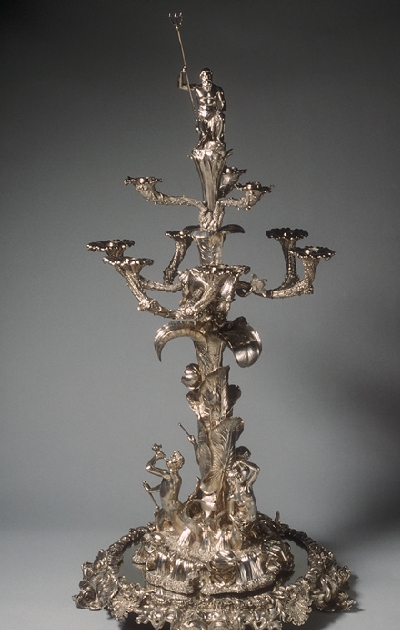 Candelabrum with Stand, 1838, Paul Storr, The Metropolitan Museum of ArtSilver, H. 88.9 cm
Candelabrum with Stand, 1838, Paul Storr, The Metropolitan Museum of ArtSilver, H. 88.9 cm
This imposing centerpiece meant for the middle of a table has two tiers for candles, the upper with three arms, the lower with three double-arms, creating nine lights overall. The candle light served to emphasize the figure of Poseidon, the Greek sea god known to the Romans as Neptune. He sits in the midst of tall reeds. The ocean-Poseidon theme is continued in the seaweed and coral that wrap the candle arms and by the figures around the base—a triton blowing a conch shell with which he calms the waters, and a nereid, both with bodies dividing into double fish tails. Dolphins, sacred to Poseidon, sport around the lower tier of candle arms and support the mirrored stand. The figures stand as though in shallows with sharp rocks and cascades of water between them. The centerpiece gives its greatest effect when the candles are lit. Then the surface of the stand reflects the candle light, giving an impression of glittering sea foam and reflecting light back up to the central composition.
On the back of Poseidon's rocky throne, a hand-inscribed date, "December 15th 1938," tells us that this was one of the last pieces made by Paul Storr. He was associated with John Mortimer as retailer and business partner since 1822. They had retail premises in New Bond Street, in the fashionable Mayfair district behind Piccadilly, and manufacturing workshops in Grey's Inn, near the commercial and business district of London. They were jewelers, goldsmiths, and silversmiths to Queen Victoria.
The intrusion of a lotus plant with leaves and flowers that wraps the central shaft and the seaweeds and corals of the candle arms indicate the growing interest in naturalism, which became a major design resource throughout the middle third of the nineteenth century.
Victoria's accession to the throne in 1837 inaugurated a change in the national consciousness toward greater propriety, which impacted many aspects of public life as well as domestic interiors and furnishings. A strong pictorialism was adopted early in her reign and had a long vogue. She had been queen for a year and a half when this candelabrum was made.
Source: Heilbrunn Timeline of Art History, The Metropolitan Museum of Art
 Top
Top Site Map
Site Map References
References About Me
About Me